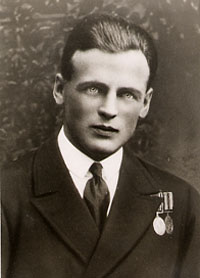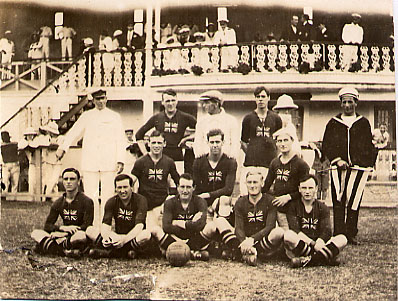Francis (Frank) Hiorns

Place of birth: Ragley Hall, Warwickshire, England
Parents: Bejamin and Rosina Hiorns
Wife: 1. Kathleen Hiorns; 2. Margaret Hiorns
Service: Royal Navy
Rank: Engineer
Service Number: M18340
Joined Hood: 7th December 1920 (Engine Room Artificer 5th Class)
Left Hood: 5th January 1923 (Acting Engine Room Artificer 4th Class)
Biographical Information:
This biography is based upon an article written by Audrey Moxham for the Pinner Local History Society. It covers the life of Frank Hiorns, who during the late 1990s, was the oldest surviving veteran of Hood's original commission.
Frank Hiorns was born on 5th February 1900 at Ragley Hall in Warwickshire, the home of the Marquis of Hertford. Frank's mother looked after the Hertford sons, Lords Edward and Henry, whom Frank met later. On a visit to the Hall in 1919, the Marquis, with pride, showed Frank a picture in the Blue Room of one of the sons who had been killed in the Great War.
Frank's father was a graduate of Nottingham University, who became a teacher and later headmaster of a school of 800 pupils in Coventry. The family lived in Stoke Park near Gosford Green, now part of Coventry.
Frank remembers that when he was six or seven years old and living in Stoke Park, which is only a few hundred yards from the city football ground in Highfield Road, he was able to see the last half of the match for free as he was under 14. This stimulated a lifetime interest in football.
In 1920 he was invited to join Coventry City Football Club as he showed a talent in the game, but he declined as he did not want to leave the Navy. In 1996 he was invited back to the Club for a dinner to celebrate the opening of a new stand.
Frank remembers walking with his father to Coombe Abbey in 1907 to pay a penny to see a man fly. The pilot took off, flew around in a circle and was not in the air above two or three minutes. In 1911 he went to London with his father for the funeral of King Edward VII. The fare was four shillings or five shillings - 20 or 25 pence today.
In 1915 some of Frank's friends volunteered to serve in the forces. Frank decided to do likewise and joined the Royal Navy. He was sent to Devonport and became an engineer. His war experiences he describes as uneventful, "you were just doing your job!"
Frank remembers the German Fleet arriving at Scapa Flow in 1919, when they surrendered. The allies steamed towards it as it came all in line, and then, with ships on either side, escorted it into Scapa Flow. For many years Frank used a pair of binoculars which came from one of the scuttled German battleships both as an aid to his own failing sight and to watch his wife Margaret playing bowls which she did for her club, county and was an international table tennis player in the 1950s.
He was commissioned to be a member of the first crew to join HMS Argus at Rosyth. This was the first flush-deck ship built specifically to allow aeroplanes to lake off and land. Prior to this a plane could take off from a converted battleship, but it could not land again. HMS Argus sailed down to Vigo Bay, off the coast of Spain, where Flying Officer Oppenshaw became one of the first men ever to take off from this aircraft carrier and to land on it. Frank visited him for the last time in the early 1990s, just before he died.
The aircraft carrier always steered into the wind so that the aircraft took off directly into the wind. There were nets at the sides of the boat where the crew stood ready for the aircraft landing or a mishap. All the sailors rushed onto the deck to grab the plane when it landed to stop it going forward. It had grips underneath which on landing attached themselves to wire hawsers across the top of the deck, causing it to come to rest. Unfortunately there were mishaps and planes crashed overboard. On both sides of the deck there were two life-saving motor boats with six-cylinder Thorneycroft engines. As soon as an aircraft went overboard the boats were lowered and went to the rescue of the pilot and if possible the engine.
HMS Hood built on the Clyde and was sent to Rosyth to be fitted out. The first crew came from Devonport and included Frank. They sailed with HMS Repulse to the Brazilian Centenary. Frank represented England and the Navy at football whilst in Brazil. Pathe Gazette filmed the matches and these were relayed to England where Frank's family saw them at the cinema two or three times in one week. A very proud family! As well as attending functions and playing football there was sight-seeing before sailing to the West Indies. The Hood called at Trinidad, Barbados. St Lucia and Dominque. He played two matches in Trinidad that they won but football was not what it is today. On one of the fleet's visits to Spain, he played against Barcelona, one of Europe's leading teams today but they did not even have a grandstand at that time. At this time not only was he playing football for the Navy but also representing them in boxing. He was a featherweight but gave up after he was knocked out but not before he had become a champion in 1919 and 1920. When he returned to England after leaving the West Indies he was paid off and went to HMS Valiant.
The banns of his future marriage were read out at Sunday morning Service on HMS Valiant. He was married in 1922 to Kathleen Jackson at St Mary's Church, Warwick, a church of Norman origin with a 12th century crypt. Their only daughter was born on 2 December 1930. After his marriage he went to China on the Valiant. This commission lasted two years, sailing 1000 miles up the Yangtze River to Hangkow. On returning to Shanghai they sailed further North to Weihaiwei, returning south to Hong Kong when the snows came. The old term "join the Navy and see the world" applied in Frank's case.
Frank left the Navy in the mid 1930s and during the war went to a factory where he supervised the making of parts of machinery used in the invasion of Europe. He continued in this field, running his own business until 1955, when he retired and moved to Hatch End where he had a bungalow built by 'Horace Cutler'. During the war he was a member of the Ealing Auxiliary Fire Service. On his move he continued with his main interests in gardening and bowls. Casual visitors used to ask him if they could see his show of over a 100 delphiniums, of all colours. He used to bowl on the Guinness ground at Park Royal and was selected to play in Australia and Hong Kong in the late 1960s. He was fortunate in being able to play until he was 88, when he had his first hip replacement, followed by the second when he was 90. His surgeon said he was the oldest person he had operated on. When Frank joined the Royal Navy he visited a gentleman in the Plymouth area who was researching the name Hiorns. He told Frank that he had only traced 76 people with that name rather than the more common spelling of Hirons. The name had been traced back to the Vikings who spelled it HOJORNS. Frank's second wife, Margaret, is a talented sportswoman who went to Fairfield Grammar School where she was house Captain for hockey, tennis and swimming. In 1952 she joined West Ealing Sports Club where she met Frank's daughter. Margaret and Frank shared a keen interest in bowls. Frank's recipe for a long life was not smoking, remaining active and diet which included cornflakes, porridge and walnuts every day. Plus a drink of Guinness, scotch or brandy, though Frank says he had never been drunk.
Sadly, Frank died on2 December 1999, three months short of his 100th birthday.
History of ships served in and ratings held:
| Date From | Date to | Ship | Rating | Source |
| 3rd January 1916 | 31st December 1919 | Indus | Boy Artificer | ADM188/1054 |
| 1st January 1920 | 3rd January 1920 | Indus | Engine Room Artificer 5th Class | ADM188/1054 |
| 4th January 1920 | 24th March 1920 | Vivid II | Engine Room Artificer 5th Class | ADM188/1054 |
| 25th March 1920 | 20th September 1920 | Argus | Engine Room Artificer 5th Class | ADM188/1054 |
| 21st September 1920 | 6th December 1920 | Vivid II | Engine Room Artificer 5th Class | ADM188/1054 |
| 7th December 1920 | 31st December 1920 | Hood | Engine Room Artificer 5th Class | ADM188/1054 |
| 1st January 1921 | 22nd January 1922 | Hood | Acting Engine Room Artificer 4th Class | ADM188/1054 |
| 23rd January 1922 | 5th January 1923 | Hood | Engine Room Artificer 4th Class | ADM188/1054 |
| 6th January 1923 | 1st February 1923 | Vivid II | Engine Room Artificer 4th Class | ADM188/1054 |
| 2nd February 1923 | 31st December 1923 | Valiant | Engine Room Artificer 4th Class | ADM188/1054 |
| 1st January 1924 | 17th May 1926 | Valiant | Engine Room Artificer 3rd Class | ADM188/1054 |
| 18th May 1926 | 14th June 1926 | Queen Elizabeth | Engine Room Artificer 3rd Class | ADM188/1054 |
| 15th June 1926 | 29th October 1926 | Vivid II | Engine Room Artificer 3rd Class | ADM188/1054 |
| 30th October 1926 | 26th August 1927 | Vivid II (Douglas) | Engine Room Artificer 3rd Class | ADM188/1054 |
| 27th August 1927 | 14th November 1927 | Maidstone | Engine Room Artificer 3rd Class | ADM188/1054 |
| 15th November 1927 | 31st December 1927 | Lucia | Engine Room Artificer 3rd Class | ADM188/1054 |
| 1st January 1928 | 12th February 1928 | Vivid II | Engine Room Artificer 2nd Class | ADM188/1054 |
| 13th February 1928 | 3rd September 1929 | Cornwall | Engine Room Artificer 2nd Class | ADM188/1054 |
| 4th September 1929 | 3rd February 1930 | Vivid II - IV | Engine Room Artificer 2nd Class | ADM363/196 |
| 4th February 1930 | Shore - continuous service expired | Engine Room Artificer 2nd Class | ADM363/196 |
Additional Photos |
 The football team during the 1922 cruise to Brazil |
No known memorials
Sources
Commonwealth War Graves Commission
'Register of Deaths of Naval Ratings' (data extracted by Director of Naval Personnel (Disclosure Cell), Navy Command HQ, 2009)
Margaret Hiorns
